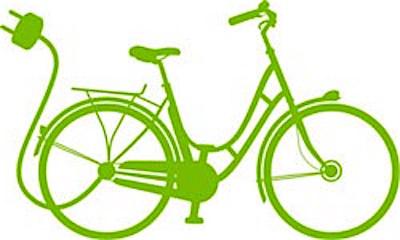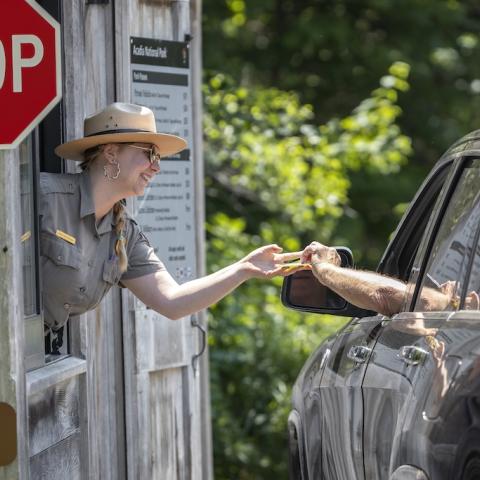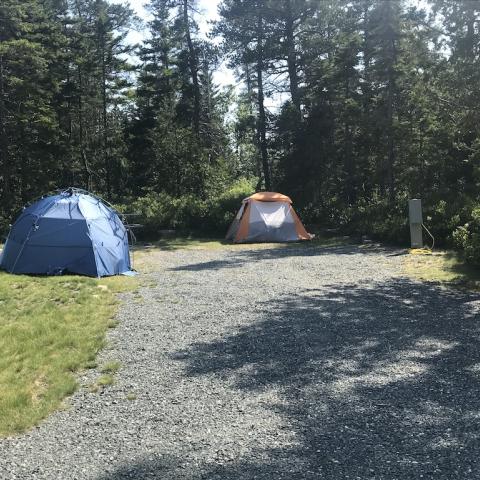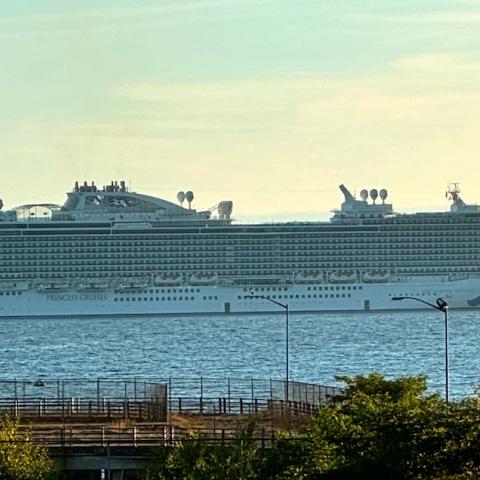
eBike riders caught on the Carriage Roads at Acadia National Park can be fined $130/NPS clipart
Opposition to allowing eBikes on non-motorized trails in the federal lands system has been voiced by dozens of conservation groups, who fear permitting the motorized bikes on those trails will create a "slippery slope" that will lead to future problems with managing those trails.
In a letter to the chief of the U.S. Forest Service, the acting director of the National Park Service, and the acting director of the U.S. Bureau of Land Management, the groups stated that they "oppose any effort that would allow any class of vehicle with a motor – including all classes of e-bikes, which by definition have a motor – to be allowed on non-motorized trails."
The issue came to light earlier this summer at Acadia National Park in Maine, where eBike users were told they could not ride on the Carriage Roads that wind through the park on Mount Desert Island. Fines for those caught on the roads start at $130, according to the park's website.
Discussion of that ban on National Parks Traveler spurred comments from many eBike users who said the bikes allow them to enjoy areas of parks that they normally couldn't walk to due to declining health.
"Apart from ebike commuters, I believe you will find ebikers to be an older, less fit demographic with some medical issues. We are not speed focused. Don't shut us out without at least a trial period," wrote DML.
In Traveler's weekly podcast, Kristen Brengel of the National Parks Conservation Association and Phil Francis of the Coalition to Protect America's National Parks voiced concern over allowing eBikes on non-motorized trails, and said the National Park Service needs to evaluate the issue carefully and fully and, if the decision is made to provide more access to the bikes beyond existing motorized routes, adopt strict regulations that outline where the various classes of eBikes are allowed to travel.
There are three "classes" of eBikes:
* Class 1: eBikes that are pedal-assist only, with no throttle, and have a maximum assisted speed of 20 mph.
* Class 2: eBikes that also have a maximum speed of 20 mph, but are throttle-assisted.
* Class 3: eBikes that are pedal-assist only, with no throttle, and a maximum assisted speed of 28 mph.
"Class 2 may not be suitable for singletrack mountainbike trails - it has been shown that they pose greater physical damage to trails due to the throttle-actuation," writes eBike manufacturer Bosch on its website. "Class 2 may be better suited for multi-use OHV trails designed for more rugged off-road vehicles.
"Class 3 eBikes are typically allowed on roads and on-road bike lanes (“curb to curb” infrastructure), but restricted from bike trails and multiuse paths. While a 20-mph maximum speed is achievable on a traditional bicycle, decision makers and agencies consider the greater top-assisted speed of a Class 3 eBike too fast for most bike paths and trails that are often shared with other trail users."
The conservation organizations, which range from the Addison Oaks Trail Riders to the Yankee Springs Trail Riders Association, say motorized vehicles should be kept separate from trails used by hikers and horseback riders.
"Non-motorized trails were created to ensure that the public could find recreational trail opportunities free from the ever-growing motorization and mechanization," reads the letter. "Millions of public land users including hikers, backpackers, hunters, horse packers, climbers, mountain bikers and many more, value non-motorized trails for recreation. Opening non-motorized trails to motors would forever change the backcountry experience for these users.
"We recognize that e-bikes have a place on public lands and generally should be allowed where motorized vehicles are permitted. The existing motorized trail system provides plentiful opportunities for e-bike use with tens of thousands of miles of trails currently open to their use."
There are groups organized to lobby for greater access for eBikes. PeopleforBikes strives to get more people across the country on bikes, and the growing popularity of eBikes hasn't been overlooked by this group. On their site are a number of papers discussing the benefits of eBikes. One even examines motorized mountain bikes and perceptions about them.
While the popularity of pedal-assist electric bikes (eBikes) generally is growing, electric-mountain bikes (eMTB) have not received a warm welcome by many within the mountain biking community. Anecdotally, a variety of concerns have been raised concerning eMTB use, including trail damage, trail confict, decreased trail access, and the perception that eMTB use is not “real” mountain biking or is “cheating.”
The outcome of that paper was that, "(T)hree predominant themes emerged: What is an eMTB?, Trails, and How should eMTBs be used? There was general confusion about the features and capabilities of eMTBs except by those who had previously used one. Commenters expressed concern over a variety of trail-related issues, including that eMTBs will damage trails similar to the way motorized vehicles do and that they could cause restricted access to some trail systems. There were inconsistent opinions on the use of eMTBs, where some comments saw riding mountain bikes as a 'rite of passage' and that using an eMTB was 'cheating.' There was some level of acknowledgement that eMTBs may be useful for promoting exercise, but this was mediated by the 'rite of passage' belief.'"
According to PeopleForBikes, there already are "more than 300,000 miles of singletrack, doubletrack, and natural surface roads accessible to motorized users."
In their letter of opposition, the conservation organizations wrote that allowing eBikes on non-motorized trails "is ill-advised and would undermine nearly a half century of management precedents and practices. First, allowing e-bikes on non-motorized trails would be un-manageable and send agencies down a slippery slope towards allowing further motorization of trails and potentially the entire backcountry. Federal land managers simply do not have the resources to police e-bikes on trails."
"Second, permitting e-bikes on non-motorized trails is contrary to long-standing 'travel management' laws and policies dating back to the Nixon administration that require all motorized recreational uses of our public lands to be confined to a system of designated roads, trails, and areas. Among other requirements, motorized trails must be located to minimize conflicts with other recreational uses of the public lands, as well as damage to soil, water, and other public land resources and harassment of wildlife."
Currently, the groups concluded, there are multiple opportunities for users to enjoy both motorized and non-motorized opportunities on public lands. However, they added, "(O)pening non-motorized trails to motorized bikes would effectively eliminate the non-motorized, primitive recreational opportunities."
Here's the list of those groups that signed the letter:
Addison Oaks Trail Riders
Allegan County Pleasure Riders
American Endurance Ride Conference
American Hiking Society
American Flyers
Appalachian Trail Conservancy
Back Country Horsemen of America (and the 30 BCH states and 196 chapters, full listing at end)
Bay Area Barns and Trails
Blue Ridge Horsemen's Association
Brighton Trail Riders Association
Canalway Partners-Board Member
Carolina Mountain Club
Colorado Mountain Club
Colorado Plateau Mountain Bike Trail Assoc, Inc.
Conserving Carolina
Continental Divide Trail Coalition
County Line Riders of Catalina, Inc
Dallas Off Road Bicycle Association (DORBA)
East Mountain Regional Trails Council
Fort Custer Horse Friends Association
Grand Valley Trails Alliance
Greater Yellowstone Coalition
Highlands Plateau Greenway
Ice Age Trail Alliance
Idaho Trails Association
Indiana Trails Community
Ionia Horse Trails Association
Kensington Trail Riders
Maybury Trail Riders
Michigan Horse Council
Michigan Trail Riders Association
Montana Wilderness Association
Montana Backcountry Alliance
National Parks Conservation Association
Natural Resources Council of Maine
Nickel Plate Trail, Inc
North Carolina Horse Council
North Country Trail Association Incorporated
Oregon Equestrian Trails
Oregon Horse Council
Overmountain Victory Trail Association
Pacific Crest Trail Association
Partnership for the National Trails System
Pinckney Trail Riders Association
Pisgah Trailblazers
Pontiac Lake Horseman’s Association
Proud Lake Trail Riders
Quiet Trails Group
Rose Oaks Equine Adventurers
San Luis Valley Ecosystem Council
Tri-County Horse Association
The Wilderness Society
Winter Wildlands Alliance
Yankee Springs Trail Riders Association




 Support Essential Coverage of Essential Places
Support Essential Coverage of Essential Places







Comments
So your going to stone wall older folks and those with disabilities ... That will just lead to unneeded conflict and hostility with no outcome. There are laws against that, Disturbing the Peace and disorderly conduct.
This comment was edited to remove gratuitous language.--Ed.
Low speed peddle assist bikes (Class 1) are not motorized vehicles as they are not "self propelled". Look up the dictionary definition of a motorized vehicle - being self propelled is the key. The small motor in a low speed peddle assist bike instead simply boosts your leg power allowing older people to bike up hills that would otherwise prevent them from using a bike and enjoying our collective biking trails. If you don't peddle, you get no boost. The boost is limited to speeds under 20 mph. Low speed peddle assist bikes go no faster than a traditional bike, except uphill where older riders can now keep up with fit 20 somethings. I never use the boost on flat ground unless there is a headwind and downhill you're not peddling so there is no boost. A low speed peddle bike is no more motorized then those traditional bike that has a motorized shifter.
Low speed peddle assist bikes should be allowed anywhere traditional bikes are allowed. Limiting them is not protecting the environment as they do no more harm than a traditional bike - restricting them is an effort to keep people out of our collective wilderness that we all need to enjoy, protect and appreciate. Older people that can afford peddle assist bikes are typically those that contribute to Land Trusts and other organizations that expand and protect our wilderness areas. Environmental groups should be endorsing low speed peddle assist bikes as a clean and environmentally friendly way to visit the wilderness. Let's put our efforts and monies into expanding our wilderness areas rather than trying to limit access to us older riders on low speed peddle assist bikes.
This is just an attempt to discriminate against eBikers. Regular bikers are just upset they may see more people using eBikes in the same places they use regular bikes. This is just an attempt to create an argument where there shouldn't be one. Current eBikes should be classified EXACTLY the same as regular bikes. The whole subject is dumb. When eBikes are so noisy they're all you can hear in the mountains or when they're so powerful they rip the ground apart like modern gasoline motorcycles currently do then you have something to bi*** about. Right now, there's absolutely NO DIFFERENCE so shut up and share the roads, trails and paths regular bikes ride on. Take up a new sport if you can't keep your emotions in check babies...
Amen Sister, well spoken! And what about disabled vets wanting to get onto an E bike and have some fun outdoors? The one that really stands out is the young child with a disabiltiy that precludes them from being able to bike with other children or family members? For that child, an E bike would be the best thing ever! The injuried athelete needing to rehab? The average overweight american overworked at their desk job, but discovering how much they enjoy riding in nature on their ebike. Really it is everyone, including the E bike haters as it is just a matter of time till accident, illness, age or some form of disability prevents them from being able to ride, then they will want an E bike to ride on singletrack trails.
I've never run into another ebiker on the trails or at the beach in Connecticu.
My first reaction to emtb's was, no way, that's for lazy or old or old laxy people. Then I became older and developed a heart condition that kept me off my beloved bike for a period of time. During that time I became less fit and my heart was damaged, so now I see the ebike in a entirely different way. I demo'ed one, purchased it and I'm loving life! I can exercise again on a bicycle and even keep up on a group ride. All of the arguments against emtb's don't hold water. Mine has wider tires than my old hardtail, the motor is only heard by me. I'm not flying by my mates on uphills, on downhills I'm not using the motor. My wide tires are easier on the trail. I just blend in. The ebike haters are motivated by either ignorance, pride, or maybe they just love to hate, (is that possible?). But look guys you are not alone, the TdF didn't allow derailleurs years after they were commonly used. There was a time that women couldn't vote, people of color couldn't use whites only bathrooms. Your prejudice is noted and is not uncommon, but in the end the silliness of your argument will be seen for what it is. I'm certain ebikes are here to stay and you'll be seeing families, old, young, and every other type person riding them. If that's a problem stay off the trails.
So only young fit people can walk on your path if you are old have a bad foot or leg sorry you can't use this path
My thoughts exactly. Stop the rhetoric, do some studies and let the data state the facts.